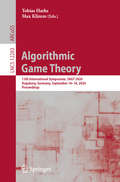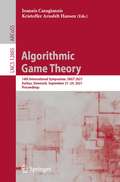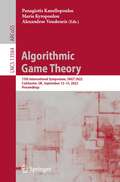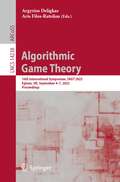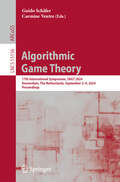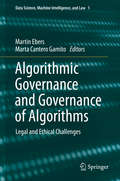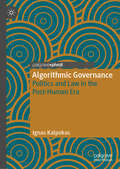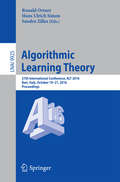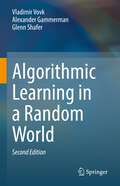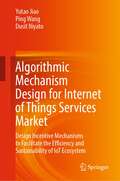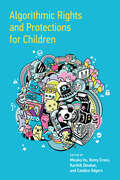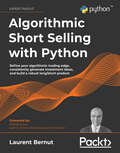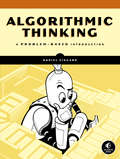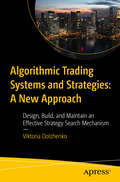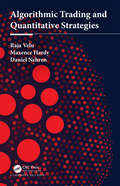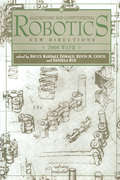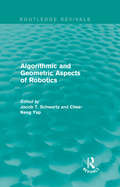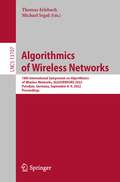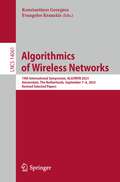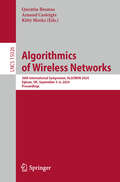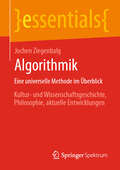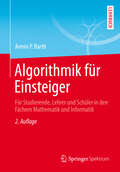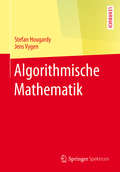- Table View
- List View
Algorithmic Game Theory: 13th International Symposium, SAGT 2020, Augsburg, Germany, September 16–18, 2020, Proceedings (Lecture Notes in Computer Science #12283)
by Tobias Harks Max KlimmThis book constitutes the refereed proceedings of the 13th International Symposium on Algorithmic Game Theory, SAGT 2020, held in Augsburg, Germany, in September 2020.* The 21 full papers presented together with 3 abstract papers were carefully reviewed and selected from 53 submissions. The papers are organized in topical sections named: auctions and mechanism design, congestion games and flows over time, markets and matchings, scheduling and games on graphs, and social choice and cooperative games. * The conference was held virtually due to the COVID-19 pandemic.
Algorithmic Game Theory: 14th International Symposium, SAGT 2021, Aarhus, Denmark, September 21–24, 2021, Proceedings (Lecture Notes in Computer Science #12885)
by Ioannis Caragiannis Kristoffer Arnsfelt HansenThis book constitutes the refereed proceedings of the 14th International Symposium on Algorithmic Game Theory, SAGT 2021, held in Aarhus, Denmark in September 2021.*The 26 full papers presented together with 4 abstract papers were carefully reviewed and selected from 73 submissions. In addition, the volume contains abstracts from 3 invited talks and 2 tutorial talks. The papers are organized in topical sections named: auctions and mechanism design, computational aspects of games, markets and matchings, and social choice and cooperative games. * The conference was held virtually due to the COVID-19 pandemic.
Algorithmic Game Theory: 15th International Symposium, SAGT 2022, Colchester, UK, September 12–15, 2022, Proceedings (Lecture Notes in Computer Science #13584)
by Panagiotis Kanellopoulos Maria Kyropoulou Alexandros VoudourisThis book constitutes the proceedings of the 15th International Symposium on Algorithmic Game Theory, SAGT 2022, which took place in Colchester, UK, in September 2022. The 31 full papers included in this book were carefully reviewed and selected from 83 submissions. They were organized in topical sections as follows: Auctions, markets and mechanism design; computational aspects in games; congestion and network creation games; data sharing and learning; social choice and stable matchings.
Algorithmic Game Theory: 16th International Symposium, SAGT 2023, Egham, UK, September 4–7, 2023, Proceedings (Lecture Notes in Computer Science #14238)
by Argyrios Deligkas Aris Filos-RatsikasThis book constitutes the proceedings of the 16th International Symposium on Algorithmic Game Theory, SAGT 2023, which took place in Egham, UK, in September 2023. The 26 full papers included in this book were carefully reviewed and selected from 59 submissions. They were organized in topical sections as follows: computational aspects and efficiency in games; computational social choice; fair division; matching and mechanism design.
Algorithmic Game Theory: 17th International Symposium, SAGT 2024, Amsterdam, The Netherlands, September 3–6, 2024, Proceedings (Lecture Notes in Computer Science #15156)
by Guido Schäfer Carmine VentreThis volume constitutes the refereed proceedings of 17th International Symposium on Algorithmic Game Theory, SAGT 2024, held in Amsterdam, The Netherlands, during September 3–6, 2024. The 29 full papers included in this book were carefully reviewed and selected from 84 submissions. They were organized in topical sections as follows: matching; fair division and resource allocation; mechanism design; game theory and repeated games; pricing, revenue, and regulation; matroid theory in game theory; information sharing and decision making; computational complexity and resource allocation.
Algorithmic Governance and Governance of Algorithms: Legal and Ethical Challenges (Data Science, Machine Intelligence, and Law #1)
by Marta Cantero Gamito Martin EbersAlgorithms are now widely employed to make decisions that have increasingly far-reaching impacts on individuals and society as a whole (“algorithmic governance”), which could potentially lead to manipulation, biases, censorship, social discrimination, violations of privacy, property rights, and more. This has sparked a global debate on how to regulate AI and robotics (“governance of algorithms”). This book discusses both of these key aspects: the impact of algorithms, and the possibilities for future regulation.
Algorithmic Governance: Politics and Law in the Post-Human Era
by Ignas KalpokasThis book analyses the changes to the regulation of everyday life that have taken place as a result of datafication, the ever-growing analytical, predictive, and structuring role of algorithms, and the prominence of the platform economy. This new form of regulation – algorithmic governance – ranges from nudging individuals towards predefined outcomes to outright structuration of behaviour through digital architecture. The author reveals the strength and pervasiveness of algorithmic politics through a comparison with the main traditional form of regulation: law. These changes are subsequently demonstrated to reflect a broader shift away from anthropocentric accounts of the world. In doing so, the book adopts a posthumanist framework which focuses on deep embeddedness and interactions between humans, the natural environment, technology, and code.
Algorithmic Learning Theory: 27th International Conference, ALT 2016, Bari, Italy, October 19-21, 2016, Proceedings (Lecture Notes in Computer Science #9925)
by Ronald Ortner, Hans Ulrich Simon and Sandra ZillesThis book constitutes the refereed proceedings of the 27th International Conference on Algorithmic Learning Theory, ALT 2016, held in Bari, Italy, in October 2016, co-located with the 19th International Conference on Discovery Science, DS 2016. The 24 regular papers presented in this volume were carefully reviewed and selected from 45 submissions. In addition the book contains 5 abstracts of invited talks. The papers are organized in topical sections named: error bounds, sample compression schemes; statistical learning, theory, evolvability; exact and interactive learning; complexity of teaching models; inductive inference; online learning; bandits and reinforcement learning; and clustering.
Algorithmic Learning in a Random World
by Alexander Gammerman Vladimir Vovk Glenn ShaferThis book is about conformal prediction, an approach to prediction that originated in machine learning in the late 1990s. The main feature of conformal prediction is the principled treatment of the reliability of predictions. The prediction algorithms described — conformal predictors — are provably valid in the sense that they evaluate the reliability of their own predictions in a way that is neither over-pessimistic nor over-optimistic (the latter being especially dangerous). The approach is still flexible enough to incorporate most of the existing powerful methods of machine learning. The book covers both key conformal predictors and the mathematical analysis of their properties. Algorithmic Learning in a Random World contains, in addition to proofs of validity, results about the efficiency of conformal predictors. The only assumption required for validity is that of "randomness" (the prediction algorithm is presented with independent and identically distributed examples); in later chapters, even the assumption of randomness is significantly relaxed. Interesting results about efficiency are established both under randomness and under stronger assumptions. Since publication of the First Edition in 2005 conformal prediction has found numerous applications in medicine and industry, and is becoming a popular machine-learning technique. This Second Edition contains three new chapters. One is about conformal predictive distributions, which are more informative than the set predictions produced by standard conformal predictors. Another is about the efficiency of ways of testing the assumption of randomness based on conformal prediction. The third new chapter harnesses conformal testing procedures for protecting machine-learning algorithms against changes in the distribution of the data. In addition, the existing chapters have been revised, updated, and expanded.
Algorithmic Mechanism Design for Internet of Things Services Market: Design Incentive Mechanisms to Facilitate the Efficiency and Sustainability of IoT Ecosystem
by Ping Wang Dusit Niyato Yutao JiaoThis book establishes game-theoretical frameworks based on the mechanism design theory and proposes strategy-proof algorithms, to optimally allocate and price the related IoT services, so that the social welfare of IoT ecosystem or the service provider’s revenue can be maximized and the IoT service provision can be sustainable. This book is written by experts based on the recent research results on the interaction between the service providers and users in the IoT system. Since the IoT networks are essentially supported by data, communication, and computing resources, the book focuses on three representative IoT services, including the data analytics services, the cloud/fog computing services for blockchain networks, and the wireless powered data crowdsourcing services. Researchers, scientists, and engineers in the field of resource allocation and service management for future IoT ecosystem can benefit from the book. As such, this book provides valuable insights and practical methods, especially the novel deep learning-based mechanism that can be considered in the emerging IoT technology.
Algorithmic Rights and Protections for Children
by Mizuko Ito, Remy Cross, Karthik Dinakar, and Candice OdgersEssays on the challenges and risks of designing algorithms and platforms for children, with an emphasis on algorithmic justice, learning, and equity.One in three Internet users worldwide is a child, and what children see and experience online is increasingly shaped by algorithms. Though children&’s rights and protections are at the center of debates on digital privacy, safety, and Internet governance, the dominant online platforms have not been constructed with the needs and interests of children in mind. The editors of this volume, Mizuko Ito, Remy Cross, Karthik Dinakar, and Candice Odgers, focus on understanding diverse children&’s evolving relationships with algorithms, digital data, and platforms and offer guidance on how stakeholders can shape these relationships in ways that support children&’s agency and protect them from harm. This book includes essays reporting original research on educational programs in AI relational robots and Scratch programming, on children&’s views on digital privacy and artificial intelligence, and on discourses around educational technologies. Shorter opinion pieces add the perspectives of an instructional designer, a social worker, and parents. The contributing social, behavioral, and computer scientists represent perspectives and contexts that span education, commercial tech platforms, and home settings. They analyze problems and offer solutions that elevate the voices and agency of parents and children. Their essays also build on recent research examining how social media, digital games, and learning technologies reflect and reinforce unequal childhoods.Contributors:Paulo Blikstein, Izidoro Blikstein, Marion Boulicault, Cynthia Breazeal, Michelle Ciccone, Sayamindu Dasgupta, Devin Dillon, Stefania Druga, Jacqueline M. Kory-Westlund, Aviv Y. Landau, Benjamin Mako Hill, Adriana Manago, Siva Mathiyazhagan, Maureen Mauk, Stephanie Nguyen, W. Ian O&’Byrne, Kathleen A. Paciga, Milo Phillips-Brown, Michael Preston, Stephanie M. Reich, Nicholas D. Santer, Allison Stark, Elizabeth Stevens, Kristen Turner, Desmond Upton Patton, Veena Vasudevan, Jason Yip
Algorithmic Short Selling with Python: Refine your algorithmic trading edge, consistently generate investment ideas, and build a robust long/short product
by Michael Covel Laurent BernutLeverage Python source code to revolutionize your short selling strategy and to consistently make profits in bull, bear, and sideways marketsKey FeaturesUnderstand techniques such as trend following, mean reversion, position sizing, and risk management in a short-selling contextImplement Python source code to explore and develop your own investment strategyTest your trading strategies to limit risk and increase profitsBook DescriptionIf you are in the long/short business, learning how to sell short is not a choice. Short selling is the key to raising assets under management. This book will help you demystify and hone the short selling craft, providing Python source code to construct a robust long/short portfolio. It discusses fundamental and advanced trading concepts from the perspective of a veteran short seller. This book will take you on a journey from an idea (“buy bullish stocks, sell bearish ones”) to becoming part of the elite club of long/short hedge fund algorithmic traders. You'll explore key concepts such as trading psychology, trading edge, regime definition, signal processing, position sizing, risk management, and asset allocation, one obstacle at a time. Along the way, you'll will discover simple methods to consistently generate investment ideas, and consider variables that impact returns, volatility, and overall attractiveness of returns. By the end of this book, you'll not only become familiar with some of the most sophisticated concepts in capital markets, but also have Python source code to construct a long/short product that investors are bound to find attractive.What you will learnDevelop the mindset required to win the infinite, complex, random game called the stock marketDemystify short selling in order to generate alpa in bull, bear, and sideways marketsGenerate ideas consistently on both sides of the portfolioImplement Python source code to engineer a statistically robust trading edgeDevelop superior risk management habitsBuild a long/short product that investors will find appealingWho this book is forThis is a book by a practitioner for practitioners. It is designed to benefit a wide range of people, including long/short market participants, quantitative participants, proprietary traders, commodity trading advisors, retail investors (pro retailers, students, and retail quants), and long-only investors.At least 2 years of active trading experience, intermediate-level experience of the Python programming language, and basic mathematical literacy (basic statistics and algebra) are expected.
Algorithmic Thinking, 2nd Edition: Learn Algorithms to Level Up Your Coding Skills
by Daniel ZingaroGet in the game and learn essential computer algorithms by solving competitive programming problems, in the fully revised second edition of the bestselling original. (Still no math required!)Are you hitting a wall with data structures and algorithms? Whether you&’re a student prepping for coding interviews or an independent learner, this book is your essential guide to efficient problem-solving in programming.UNLOCK THE POWER OF DATA STRUCTURES & ALGORITHMS:Learn the intricacies of hash tables, recursion, dynamic programming, trees, graphs, and heaps. Become proficient in choosing and implementing the best solutions for any coding challenge.REAL-WORLD, COMPETITION-PROVEN CODE EXAMPLES:The programs and challenges in this book aren&’t just theoretical—they&’re drawn from real programming competitions. Train with problems that have tested and honed the skills of coders around the world.GET INTERVIEW-READY:Prepare yourself for coding interviews with practice exercises that help you think algorithmically, weigh different solutions, and implement the best choices efficiently.WRITTEN IN C, USEFUL ACROSS LANGUAGES:The code examples are written in C and designed for clarity and accessibility to those familiar with languages like C++, Java, or Python. If you need help with the C code, no problem: We&’ve got recommended reading, too.Algorithmic Thinking is the complete package, providing the solid foundation you need to elevate your coding skills to the next level.
Algorithmic Thinking: A Problem-Based Introduction
by Daniel ZingaroA hands-on, problem-based introduction to building algorithms and data structures to solve problems with a computer.Algorithmic Thinking will teach you how to solve challenging programming problems and design your own algorithms. Daniel Zingaro, a master teacher, draws his examples from world-class programming competitions like USACO and IOI. You'll learn how to classify problems, choose data structures, and identify appropriate algorithms. You'll also learn how your choice of data structure, whether a hash table, heap, or tree, can affect runtime and speed up your algorithms; and how to adopt powerful strategies like recursion, dynamic programming, and binary search to solve challenging problems.Line-by-line breakdowns of the code will teach you how to use algorithms and data structures like: • The breadth-first search algorithm to find the optimal way to play a board game or find the best way to translate a book • Dijkstra's algorithm to determine how many mice can exit a maze or the number of fastest routes between two locations • The union-find data structure to answer questions about connections in a social network or determine who are friends or enemies • The heap data structure to determine the amount of money given away in a promotion • The hash-table data structure to determine whether snowflakes are unique or identify compound words in a dictionaryNOTE: Each problem in this book is available on a programming-judge website. You'll find the site's URL and problem ID in the description. What's better than a free correctness check?
Algorithmic Trading Systems and Strategies: Design, Build, and Maintain an Effective Strategy Search Mechanism
by Viktoria DolzhenkoDesign and develop a complex trading system from idea to operation. Old approaches were based on manually searching for strategy ideas. This book shows you how to create a system that will generate, optimize, and launch profitable strategies into a fully automatic mode. Imagine a system that only requires access to the Internet and electricity from a trader. This book describes the architecture and features of such a system and provides recommendations for further development. Most books cover only the implementation stage and overlook the design and maintenance of these systems. Here, you’ll walk through the entire process of creating a complex, scalable and easily supported system. For example, you’ll design an application based on microservice architecture and learn about development environments. You’ll also examine the advantages of horizontal scaling in the context of creating trading systems. Along the way, you’ll set up Kubernetes, connect the monitoring system. and understand the intricacies of continuous integration and continuous delivery. Testing and identifying only dozens of strategies is a thing of the past. Algorithmic Trading Systems and Strategies: A New Approach shows you how to analyze thousands in the same amount of time.
Algorithmic Trading and Quantitative Strategies
by Raja VeluAlgorithmic Trading and Quantitative Strategies provides an in-depth overview of this growing field with a unique mix of quantitative rigor and practitioner’s hands-on experience. The focus on empirical modeling and practical know-how makes this book a valuable resource for students and professionals. The book starts with the often overlooked context of why and how we trade via a detailed introduction to market structure and quantitative microstructure models. The authors then present the necessary quantitative toolbox including more advanced machine learning models needed to successfully operate in the field. They next discuss the subject of quantitative trading, alpha generation, active portfolio management and more recent topics like news and sentiment analytics. The last main topic of execution algorithms is covered in detail with emphasis on the state of the field and critical topics including the elusive concept of market impact. The book concludes with a discussion on the technology infrastructure necessary to implement algorithmic strategies in large-scale production settings. A git-hub repository includes data-sets and explanatory/exercise Jupyter notebooks. The exercises involve adding the correct code to solve the particular analysis/problem.
Algorithmic and Computational Robotics: New Directions 2000 WAFR
by Daniela Rus Bruce Randall Donald Kevin M. LynchAlgorithms that control the computational processes relating sensors and actuators are indispensable for robot navigation and the perception of the world in which they move. Therefore, a deep understanding of how algorithms work to achieve this control is essential for the development of efficient and usable robots in a broad field of applications.
Algorithmic and Geometric Aspects of Robotics (Routledge Revivals)
by Jacob T. Schwartz Chee-Keng YapFirst published in 1987, the seven chapters that comprise this book review contemporary work on the geometric side of robotics. The first chapter defines the fundamental goal of robotics in very broad terms and outlines a research agenda each of whose items constitutes a substantial area for further research. The second chapter presents recently developed techniques that have begun to address the geometric side of this research agenda and the third reviews several applied geometric ideas central to contemporary work on the problem of motion planning. The use of Voronoi diagrams, a theme opened in these chapters, is explored further later in the book. The fourth chapter develops a theme in computational geometry having obvious significance for the simplification of practical robotics problems — the approximation or decomposition of complex geometric objects into simple ones. The final chapters treat two examples of a class of geometric ‘reconstruction’ problem that have immediate application to computer-aided geometric design systems.
Algorithmic and High-Frequency Trading
by Álvaro Cartea Sebastian Jaimungal José PenalvaThe design of trading algorithms requires sophisticated mathematical models backed up by reliable data. <P><P> In this textbook, the authors develop models for algorithmic trading in contexts such as executing large orders, market making, targeting VWAP and other schedules, trading pairs or collection of assets, and executing in dark pools. These models are grounded on how the exchanges work, whether the algorithm is trading with better informed traders (adverse selection), and the type of information available to market participants at both ultra-high and low frequency. Algorithmic and High-Frequency Trading is the first book that combines sophisticated mathematical modelling, empirical facts and financial economics, taking the reader from basic ideas to cutting-edge research and practice. If you need to understand how modern electronic markets operate, what information provides a trading edge, and how other market participants may affect the profitability of the algorithms, then this is the book for you.
Algorithmics of Wireless Networks: 18th International Symposium on Algorithmics of Wireless Networks, ALGOSENSORS 2022, Potsdam, Germany, September 8–9, 2022, Proceedings (Lecture Notes in Computer Science #13707)
by Thomas Erlebach Michael SegalThis book constitutes the refereed proceedings of the 18th International Symposium on Algorithmics of Wireless Network, ALGOSENSORS 2022, which took place in Potsdam, Germany in September 2022.The 10 full papers presented in this volume were carefully reviewed and selected from 21 submissions. ALGOSENSORS is an international symposium dedicated to algorithmic aspects of wireless networks.
Algorithmics of Wireless Networks: 19th International Symposium, ALGOWIN 2023, Amsterdam, The Netherlands, September 7–8, 2023, Revised Selected Papers (Lecture Notes in Computer Science #14061)
by Evangelos Kranakis Konstantinos GeorgiouThis book constitutes the refereed proceedings of the 19th International Symposium on Algorithmics of Wireless Networks, ALGOWIN 2023, held in Amsterdam, The Netherlands, during September 7–8, 2023.The 10 full papers included in this book were carefully reviewed and selected from 22 submissions. They were organized in topical sections as follows: design and analysis of algorithms, models of computation and experimental analysis.
Algorithmics of Wireless Networks: 20th International Symposium, ALGOWIN 2024, Egham, UK, September 5–6, 2024, Proceedings (Lecture Notes in Computer Science #15026)
by Kitty Meeks Quentin Bramas Arnaud CasteigtsThis book constitutes the refereed proceedings of the 20th International Symposium on Algorithmics of Wireless Networks, ALGOWIN 2024, held in Egham, UK, in September 2024. The 14 full papers presented here were carefully reviewed and selected from 26 submissions. These papers focus on the Algorithmic aspects of Wireless networks, including the design and analysis of Algorithms, Models of computation and Experimental analysis, involved in various types of computational entities.
Algorithmik Eine universelle Methode im Überblick: Kultur- und Wissenschaftsgeschichte, Philosophie, aktuelle Entwicklungen (essentials)
by Jochen ZiegenbalgDieses essential zeigt aus einer allgemeinbildenden und allgemeinverständlichen Perspektive, wie universell und bedeutend die algorithmische Methode ist. Es beleuchtet dabei sowohl die historischen Anfänge des algorithmischen Denkens und seine philosophischen Hintergründe als auch seine Relevanz für aktuelle Anwendungen – etwa im Bereich der Programmierung bis hin zu künstlicher Intelligenz. Die kompakte, in sich geschlossene Darstellung ist dabei weitestgehend anschaulicher Natur – ganz im Sinne der Methodologie des algorithmischen Arbeitens, die von Konstruktivität, Elementarität und explorativem Problemlösen geprägt ist. Auf technische Formulierungen wird in diesem essential so weit wie möglich verzichtet.
Algorithmik für Einsteiger: Für Studierende, Lehrer und Schüler in den Fächern Mathematik und Informatik
by Armin P. BarthWer ein GPS benutzt oder einen Routenplaner befragt, profitiert von einem Algorithmus. Wer sich von einem medizinischen Roboter operieren lässt oder beim Onlinebanking auf sicheren Datentransfer hofft, vertraut auf Algorithmen. Algorithmen und die ausführenden Computer bestimmen und beeinflussen unser heutiges Leben in starkem Maße. Im Zentrum dieses Buches steht die Frage, was ein Algorithmus ist, was Algorithmen können und was nicht. Der Leser, die Leserin erfährt, was genau ein Algorithmus ist, und hat die Möglichkeit, aus zahlreichen historisch wichtigen oder aktuellen Beispielen von Algorithmen auszuwählen. Eine Untersuchung darüber, ob und wie Algorithmen noch beschleunigt werden können, mündet in eine kurze Einführung in die moderne mathematische Disziplin der "Komplexitätstheorie". Mit der Turing-Maschine wird ein einfaches und zugleich ungeheuer mächtiges theoretisches Computermodell vergestellt, das Anlass zu interessanten Fragen über die Möglichkeiten und Grenzen der Computer gibt. Zum Schluss wird der Leser, die Leserin zu einem Ausflug eingeladen zu den Grenzen der Informatik, zu Problemen, die bewiesenermaßen algorithmisch unlösbar sind. Dank sehr ausführlicher und gut zugänglicher Erklärungen und zahlreicher interessanter Aufgaben bereitet das Lernen mit diesem Buch Freude. Der Text wurde für die zweite Auflage vollkommen neu geschrieben.
Algorithmische Mathematik (Springer-Lehrbuch)
by Stefan Hougardy Jens VygenDieses Lehrbuch vermittelt grundlegende mathematische Fähigkeiten im Hinblick auf Entwurf und Analyse von Algorithmen, sowie deren Implementierung. Neben einigen fundamentalen Algorithmen (z. B. Sieb des Eratosthenes, Euklidischer Algorithmus, Sortieralgorithmen, Algorithmen auf Graphen, Gauß-Elimination) werden auch elementare Datenstrukturen, graphentheoretische Grundlagen und numerische Fragen behandelt. Zudem werden grundlegende Programmierkenntnisse vermittelt und es wird gezeigt, wie man Algorithmen in C++ implementiert. Das Buch eignet sich besonders für den Studienbeginn und stellt den klassischen Vorlesungen über Analysis und Lineare Algebra die Algorithmische Mathematik als dritte Grundvorlesung zur Seite. Diese Vorlesung haben die Autoren in den letzten Jahren mehrfach an der Universität Bonn gehalten.
